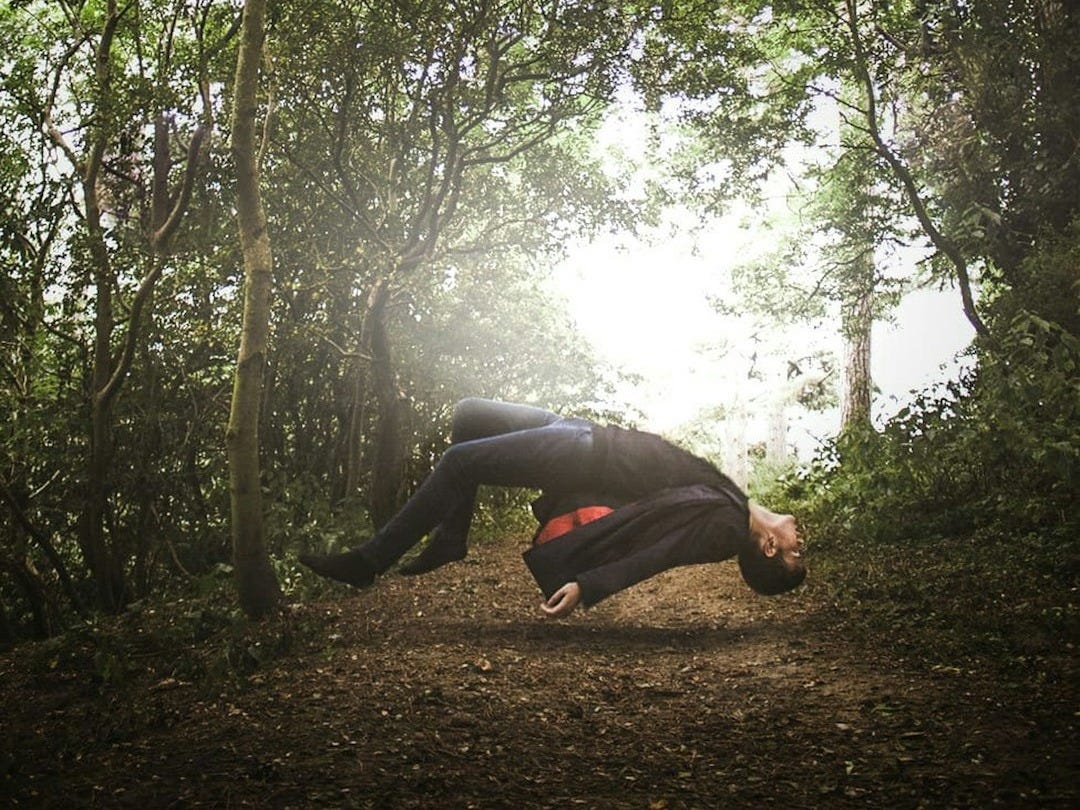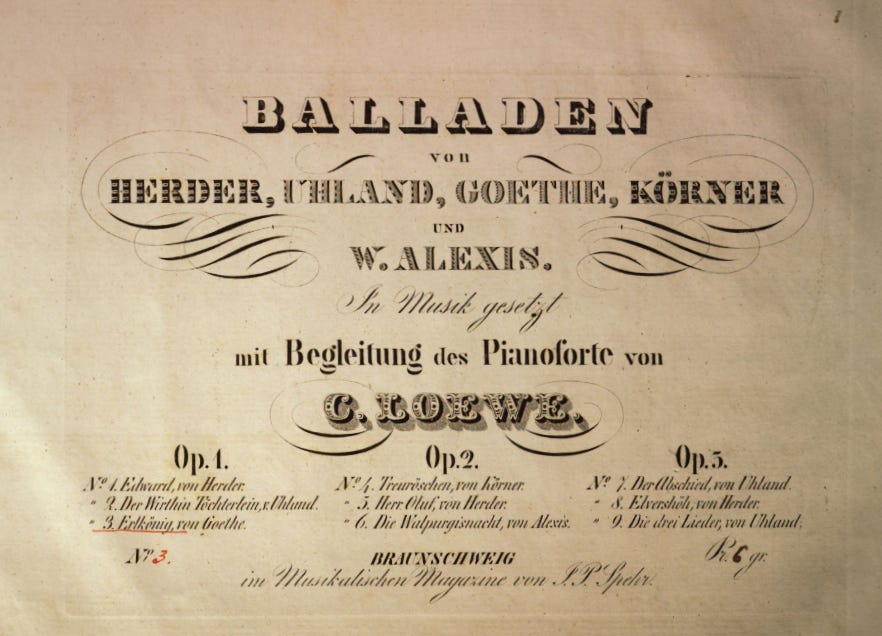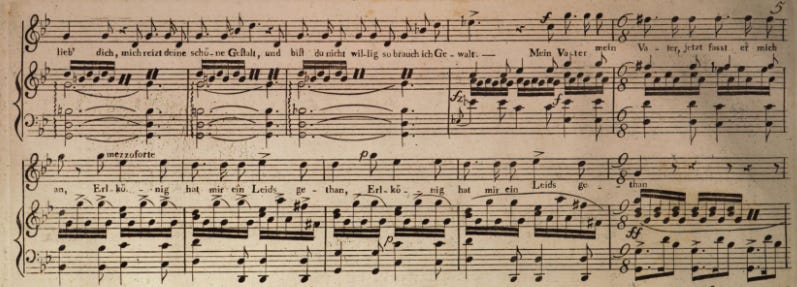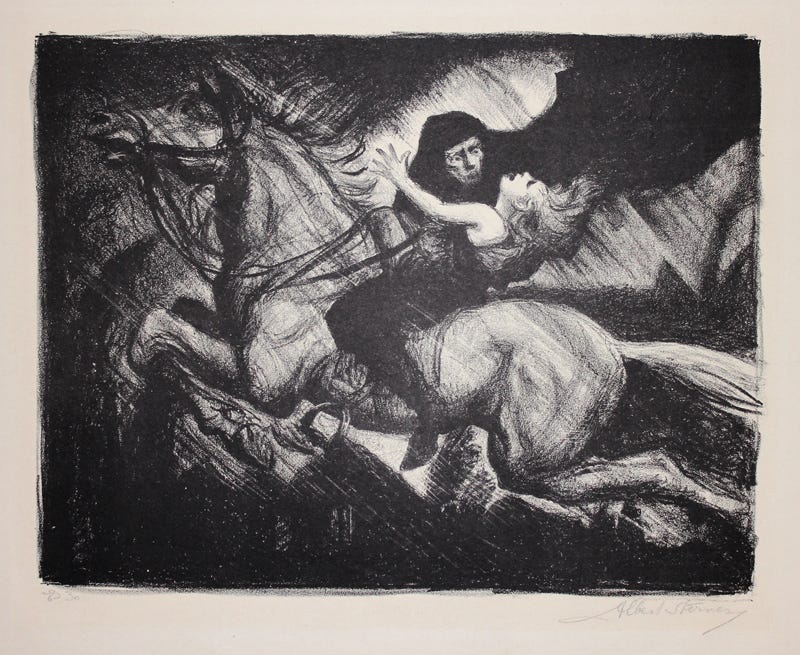The Erl King Returns: When Coaching Becomes the New Pipeline for Artists
A Sequel to Erl King Economics — From BM Degrees to DM Sales Pitches: How One Performance Economy Feeds Another
Who rides so late, through night and wind?
You do. Again.
But this time,
you’re not on horseback.
You’re in a Zoom room.
And this time, the Erl King doesn’t wear a cape.
It holds a ring light, a confident smile, and a promise:
"You’re ready. I see you. Let me help you become the six-figure artist you were always born to be."
In Goethe’s original Erlkönig, a child dies in the arms of a father who tried to outrun danger.
In today’s coaching economy, many artists do the same—whether they’re chasing a career breakthrough, or trying to be coaches themselves.
We were trained to perform—first for degrees, then for gigs, and now for conversions.
We call it reinvention.
But it’s just the artist pipeline, rebranded—and one performance economy feeding another.
We outrun. We override. We over-trust.
Because we were trained this way.
The music may change.
But the story stays the same.

What follows isn’t just a critique. It’s a decoding—of form, seduction, and the illusion of “safety” inside structurally unsound systems.
Prologue: A Familiar Tune
If something about the coaching industry feels eerily familiar for artists and performers, it’s because we were trained for it.
Not just in discipline, but in dynamic.
We were taught to trust the conductor.
To follow the baton.
To let someone else set the pace.
In the rehearsal room, we didn’t question power—we studied it, mimicked it, and obeyed it.
We were groomed to mistake form for safety.
To follow the rhythm, even as our breath ran out.
And we were praised—just enough—when we made it look effortless.
So when someone offers us hope, a calendar, and a syllabus, we respond exactly as we were taught.
We sign up. We practice. We perform.
We don’t just play the part.
We embody it.
Schubert's Erlkönig: The Performance Economy
In Franz Schubert’s Erlkönig (1815), the terror is immediate, the danger unmistakable. The piano gallops without rest. The child pleads. The father urges the horse forward—faster, faster. Each voice has its own dramatic contour, and the music never stops.
You ride until you break.
This is the performance economy:
Urgency is the tempo.
Achievement is the oxygen.
Visibility is everything.
Repeat, repeat, repeat—and be as perfect as the pianist!
Musically, Schubert’s through-composed setting offers no repetition, no return, no sanctuary. It drives forward in relentless 4/4 time, mimicking the frantic hoofbeats of a horse—triplet figures hammering throughout.
Each character is vividly differentiated:
The narrator hovers in a middle register—stable, observant.
The father, lower and more sage-like—attempting to reassure.
The child climbs higher—breathless, panicked, vulnerable.
The Erl King is more smooth, seductive, and always in deceptively soothing major keys—except for when it’s too late.
There is no release. No ritardando. No lasting authentic cadence—until it’s over.
The music mirrors the institution:
Relentless.
Complex.
Structurally impressive.
And ultimately unsparing.
It also mirrors the pounding in your heart:
With each Instagram like.
With every YAP Tracker alert.
As you read to the end of yet another “you were so close” rejection letter—
for which you paid a $50 application fee.
It’s the tension of waiting for feedback
from a system never built to offer stability.
So you ride harder.
Practice more.
Get back in the saddle.
Because the structure demands it.
In Schubert, the anxiety isn’t incidental.
It’s baked into the form.
The tension doesn’t build.
It sustains.
Until it shatters.
Loewe's Erlkönig: The Compliance Economy
Unlike Schubert’s breakneck urgency—driven by relentless triplets and shifting tonal centers that heighten anxiety—Carl Loewe offers a contrasting lull. His 1818 setting of Erlkönig moves in a gently swaying 9/8 compound triple meter, shaped by modified strophic form. The result is not propulsion, but hypnosis. A lullaby.
The accompaniment doesn’t gallop. It rocks. Like a cradle. Or a trance. Each verse returns—but to what? Not progress. Not escape. Just another rotation of suggestion.
Where Schubert uses dissonance, angularity, and vocal extremes to paint terror, Loewe hides the threat inside consonance. The Erl King sings in soft, legato phrases—always pianissimo—offering menace in the language of comfort.
This isn’t a chase. It’s a caress.
And while Schubert sharply differentiates each character through register, rhythm, and harmonic texture, Loewe intentionally blurs them. The narrator, father, and child all remain inside the tonal gravity of G minor—nearly indistinguishable in range and rhythmic contour.
Only the Erl King departs. He entrances through harmonic shift, stepping into G major—briefly, luminously—then vanishing again.
Danger never breaks the surface. It glows just long enough to persuade you.
“My dear child, won’t you come with me? I have a beautiful program just for you!”
This is the compliance economy:
Calm is the tempo.
Trust is the hook.
Gaslighting is the cadence.
Modulation becomes a tactic—not to increase drama, but to induce consent.
And it works—not because it overpowers you, but because it promises not to.
The music doesn’t demand action. It invites submission. Loewe’s setting doesn’t ask you to fight. It makes you believe there’s nothing to fear—and you may not even notice how his melodic lines subtly incorporate rhythms associated with hunting.
As I explained in my dissertation, Loewe’s psychological acuity emerges most vividly through his handling of speech rhythm and harmonic motion. It’s one of the reasons Wagner liked him more than Schubert. Unlike Schubert’s overt dramatic contrasts, Loewe internalizes the shifts. His modulations don’t aim to dazzle the audience; they mirror the unraveling of the character’s inner world.
In Erlkönig, this becomes clearest when the child breaks out of the regular strophic structure—brief, panicked outbursts that pierce the musical lull without disrupting its form. These moments land like flashes of consciousness inside a dream state. Startling. Short. Real.
Harmonically, the oscillation between G minor and G major is more than a tonal gesture—it establishes a psychological boundary. G major is not simply a parallel key. It is a false sanctuary. When the Erl King speaks in G major, it is not contrast for contrast’s sake. It is an emotional manipulation. The return to G minor is not a homecoming—it’s a reckoning.
The only time the Erl King’s melody shifts from major to minor is at the end—when the successful hunt ends and the sudden punishment for non-compliance begins.
Loewe’s score demands not just a singer, but a storyteller—one capable of holding contradiction without collapsing it. The performer must voice the manipulation as it unfolds, in real time. This is not music that tolerates oblivion. It requires discernment.
And that is precisely what mirrors the most seductive forms of modern coaching.
The verbal modulations—the pivot from flattery to urgency, from validation to emotional charge—operate like Loewe’s harmonic sleight of hand. They don’t ask for clarity. They induce devotion. Clients are not informed. They are enveloped.
And just as Loewe’s singers must navigate illusion and truth in rapid succession, so too must clients inside containers architected to earn consent—not through logic, but through tone.
In both cases, the structure is musical. But the outcome is psychological. And the damage—if you’re not conscious of what you’re consenting to—can feel just as irreversible.
The child does not run.
He listens.
And that is how the Erl King wins.

Both Versions End with Death
In Schubert’s setting, the child dies running.
In Loewe’s setting, the child dies believing.
One ends in collapse.
The other, in compliance.
Both are exquisitely structured.
Both reward precision.
Both wrap horror in harmonic beauty.
And so it is in our professional lives:
One system told you to rehearse until it hurt.
The other told you to trust until it didn’t.
But neither gave you an exit strategy.
Only a role to play.
You weren’t asked to think.
You were taught to perform.
To obey structure.
To override instinct.
To treat emotional endurance as a virtue.
You were taught to ignore what your body was trying to tell you.
Because the structure was never built to hold you.
Only to hold you in place.

The Form That Masks the Collapse
What makes these pieces so enticing to listen to—and even thrilling to perform—is their structure. Each is rooted in the classical style. Symmetry. Logical tonal progressions.
And that’s exactly what makes them dangerous.
We’ve been trained to believe that if something is well-formed, it must be safe. But both the artist pipeline and the coaching economy exploit that belief:
The artist development track offers deadlines, rubrics, and audition portals—but behind them: favoritism, financial precarity, and opaque power.
The coaching world offers Zoom calls, curated communities, and polished templates—but behind them: unsupported business models and spiritualized blame.
Both reframe structural failure as personal inadequacy.
When the system cracks, you’re told it’s
because you were not ready.
Or “not aligned “enough.
Or “not coachable” enough.
Loewe often reserves the peak of vocal range or dynamic intensity for a single, emotionally charged phrase—then drops into sudden silence. This compositional whiplash spikes your emotional investment, then denies release. The result is disorientation. Entrancement. Compliance.
The same mechanism shows up in manipulative coaching sequences: clients are pushed to an emotional climax—often visibly, in public-facing containers—then abandoned without scaffolding.
Unless you have a big advertising budget, if you don’t have a reliable stream of referrals, testimonials, or friend-clients to prop you up, you quickly learn the truth:
The structure wasn’t built to hold. It was built to peak.
It’s not structure.
It’s containment.
And it cycles—with triplets in 4/4 time.

When Artists Meet the Erl King—Again!
So why do so many artists fall for this economy twice?
Because we were conditioned to:
Obey form and structure.
Distrust instinct.
Seek validation from legacy systems.
Be rewarded for emotional endurance masquerading as excellence.
In the artist pipeline, suffering with grace was a virtue.
In coaching, suffering is reframed as a mindset problem.
Same death. New melody.
We don’t repeat this cycle because we’re foolish.
We repeat it because it feels like rigor. Like craft. Like worthiness.
But this time, we’re not preparing for a jury or a debut.
We’re preparing to be seen.
To stretch.
To step into some shinier self—
one that usually performs on command,
for someone else’s metric of value.
And where’s the extra income to show for it?
The Father as the Conscious Self
In both settings of Erlkönig, the father is there.
Trying to help.
Trying to explain the threat away.
Trying to ride faster.
He is your conscious mind—the part of you that wants to believe this will work.
The part that signs the contract.
Hopes for the result.
Tries to outrun doubt with devotion.
But he cannot stop the collapse.
If you’ve been both the child and the father—
You’re not broken.
You’re trained.
You were trained to override your instincts in favor of form.
To see the form and call it safety.
To ride harder when the rhythm got scarier.
But what if the music itself was the problem?

The Invitation to Wake Up
There is no saving the child inside these songs.
Only waking up from them.
To do that, we must:
Stop mistaking fomality for safety.
Stop equating calmness with care.
Stop trusting people who only offer roles to play.
Start composing new structures.
Compositions where we own the ink—not just read the part.
Where feedback isn’t a performance review.
Where results are built, not begged for.
Where we don’t have to collapse for someone to call it a breakthrough.
Because here’s the truth:
The first Erl King handed you an audition binder and a YAP Tracker account.
The second handed you a ring light and a mindset mantra.
Either way, the Erl King only wins if you stay asleep.
If you’ve ever wondered why coaching felt so familiar—
it’s because they promised you a voice,
but handed you recycled scripts and copy templates.
And even the money—if there’s more—is fragile, conditional, unsustainable.
But now you see it.
And once seen,
the spell is harder to recast.

WHAT TIES THESE SYSTEMS TOGETHER
Whether it’s a conservatory, an early-career track, or a modern coaching container—it’s not just about poor outcomes.
It’s about the invisible extraction underneath them.
This isn’t just disillusionment.
It’s a coercive control economy.
Both worlds are built on a subtle, sanctioned choreography of compliance:
You’re offered structure—but not sovereignty.
You’re offered support—but not autonomy.
You’re offered visibility—but only if you do as the host pleases.
It rarely looks dangerous.
It looks like belonging.
It sounds like encouragement.
It reads like feedback.
But beneath the surface, something else is happening:
You’re being asked to override your instincts to protect someone else’s narrative.
You’re being praised for surrendering—and not supported in discerning.
You’re being sold “freedom” by someone who profits from your dependence.
And because it’s wrapped in performance rituals, G major lullabies, and just enough spiritualized reassurance—it’s almost impossible to name while you’re inside it.
Sometimes pressure doesn’t scream. It smiles.
Sometimes containment doesn’t feel like a cage. It feels like groupthink.
And sometimes… because they call it community… you stay.
Not because it’s making you more money—
but because everyone else seems to believe it is.
You were told to “stretch.”
But no one asked: For what? How far? When does it end?
You were asked to record a video about your “breakthrough” before you’d even had one—because it was never about the result.
It was about the optics.
That’s not visibility.
That’s emotional labor repackaged as marketing collateral.
That’s not mentorship.
That’s management by manipulation.
There are systems that say they’re here to liberate you—but still make you “pay your dues” to earn your belonging.
They promise freedom—but only if you perform your devotion first.
They call themselves a “community.” But only if you cooperate.
Just like the G major lull of Loewe’s Erlkönig, it feels like sanctuary—until you hear the silence underneath.
And once you hear it, you can’t unhear it.
Once you see it, you can name it.
Once you name it, you can reject it.
Once you reject it, you can rebuild.
You are not behind.
You are not broken.
You are waking up.

Postlude: What This Essay Actually Does
This isn’t a rant.
It’s an interpretation.
A musical metaphor as trapdoor.
High-achieving artists—especially those trained in classical systems—will recognize themselves instantly.
But so will those who’ve endured toxic coaching programs, spiritual bypassing,
or company gaslighting disguised as “that’s just how it is.”
This essay doesn’t shame.
It reveals.
It doesn’t accuse.
It reflects.
Because if you’ve been in these kinds of systems, you weren’t naïve.
You were simply never taught to distinguish performance from manipulation.
And that’s what this essay was here to help you see.
If this resonates—quietly but deeply—send it to the friend or colleague who always knew something was off, even if they couldn’t name it.
Or message me if you’re finally ready to compose something better.
You don’t exit these systems by burning them down.
You exit by seeing the forest for what it is.
And forging a better path.
Are we out of the woods yet?
Not until we stop calling the fog clarity.
And If This Essay Resonated…
Please take a moment to read and share
The Referral List I Wish School Had Given You.
It’s a vetted list of mentors who meet structural standards most people were never taught to name—and it can help you avoid the very traps this article exposes.
Share it with students looking for guidance.
Share it with professors, advisors, and colleagues who make referrals.
Share it not just for the remarkable people featured—
but for the standards alongside them.
Standards rooted in economic integrity.
And human decency.
And if someone finds the standards or the list confronting—
they might be revealing more than they think!
NEXT UP IN “THE ERL KING TRILOGY”:
OR IF YOU MISSED PART I:
Much gratitude for reading!
Most readers stop here, feeling seen.
Others may want to explore what my work could mean for their business, curriculum, or leadership strategy:
If you’re ready to:
• Undo the high-pressure “bro-marketing” habits baked into your business
• Starve the “starving artist” mindset that keeps you attracting the wrong clients
• Build a congruent structure to fuel your next level of self-actualizing success—or—
If you:
• Run a business
• Manage a high-performance team
• Lead a legacy-focused planning firm
• Direct an academic program
• Shape an artistic institution—and you're seeking next-level clarity, curriculum recalibration, strategic design, or discreet consulting—
Let’s talk—here or on LinkedIn.
Because the systems that hold wealth, trust, and talent—
should be designed to quietly endure.














